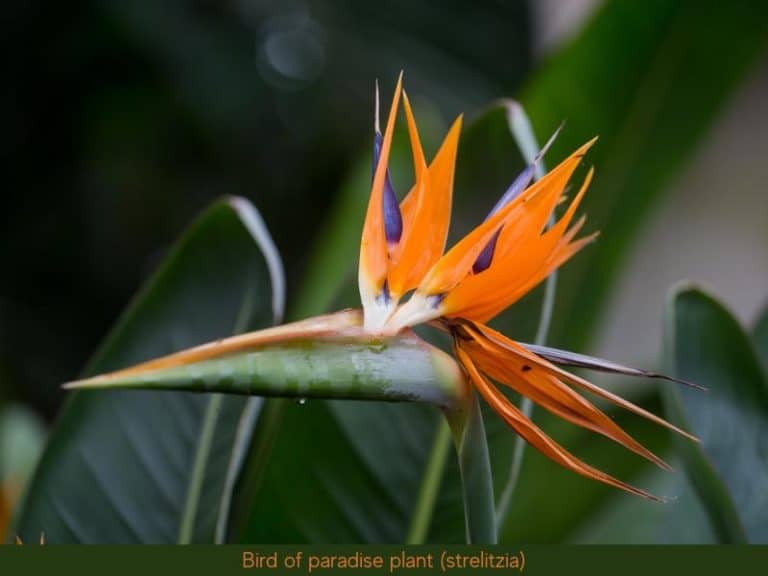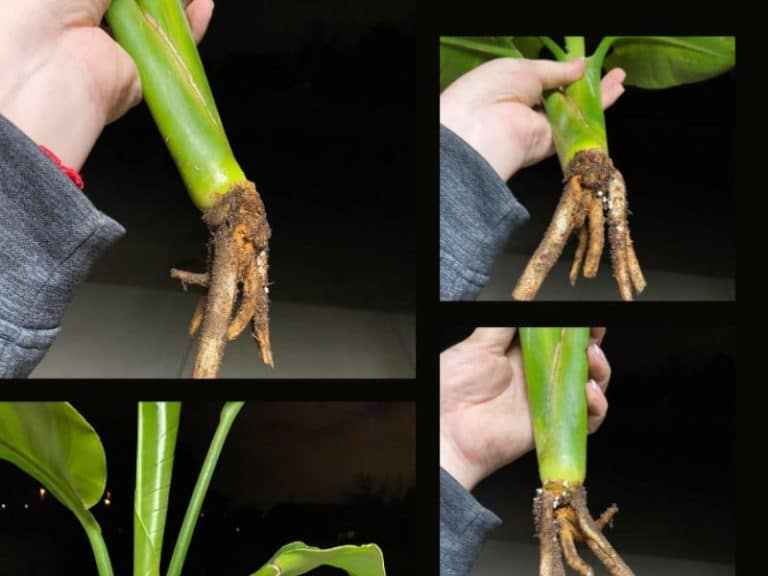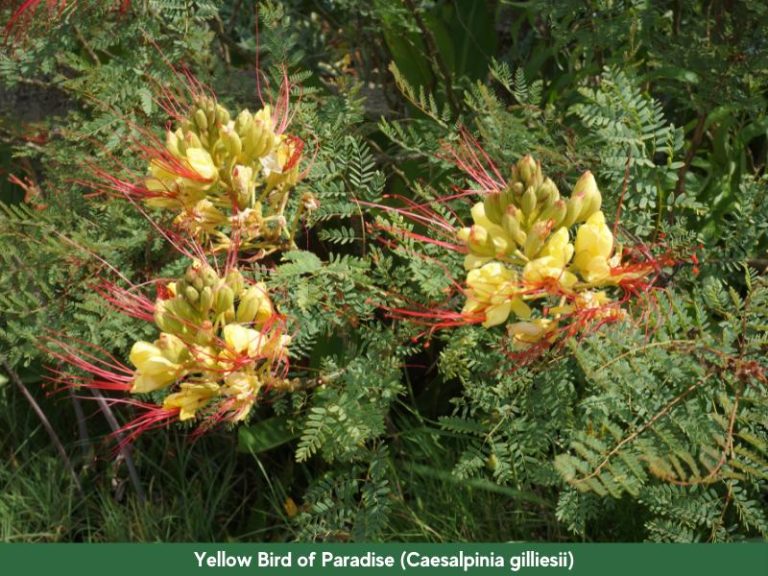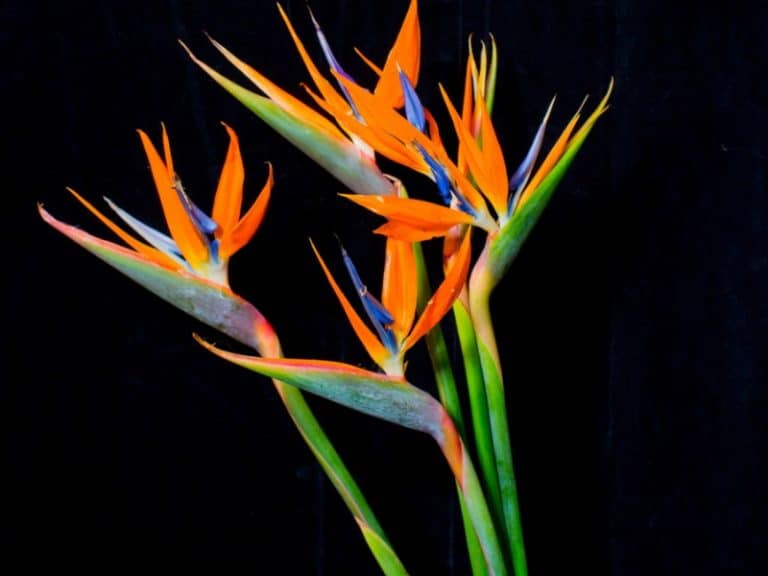9 Best Bird of Paradise Companion Plants
Companion plants are often grown with the idea that they will help each other improve growth, attract beneficial insects, fix nitrogen, deter pests, and trap cropping to increase productivity. But as much as there are good neighbors, there are also bad neighbors.
The best companion plants for Bird of Paradise include the Carolina jessamine, society garlic, bougainvillea vine, sweet olive, blue hobbit, princess lily, knifophia, asiatic jasmine, sago palm, and bromeliads.
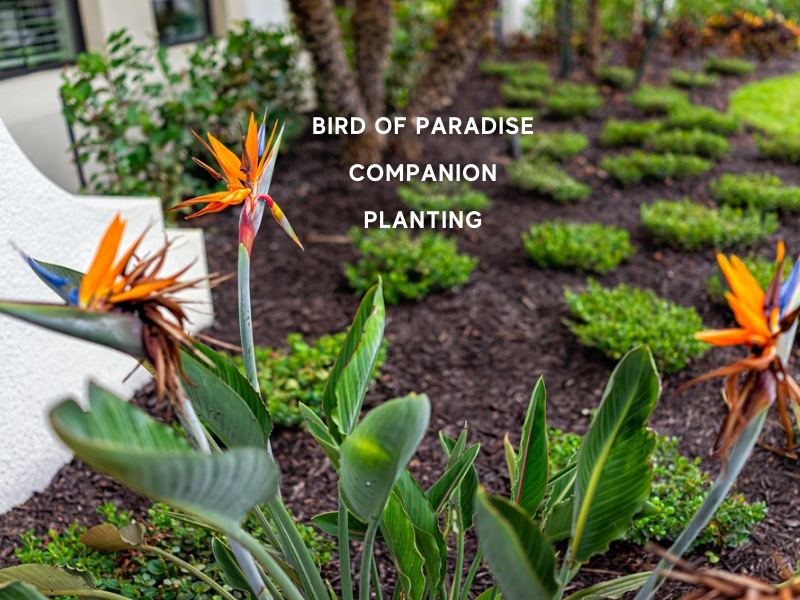
Some plants cannot stand each other and thus should not be planted closely, so check out my list of plants that should not be planted together with birds of paradise at the end.
Contents:
Plants to Pair with Bird of Paradise
Suitable companion plants for the bird of paradise plant enhance the surrounding’s appeal. They share growing conditions and make a great complementary match with the main plant.
Carolina Jessamine (Gelsemium sempervirens)
- Growing Conditions: Full sun to partial shade; rich, well-drained soil
- Size: 20 feet tall as a vine
- Zones: 6-9
- Check the price of Caroline Jasmine here.
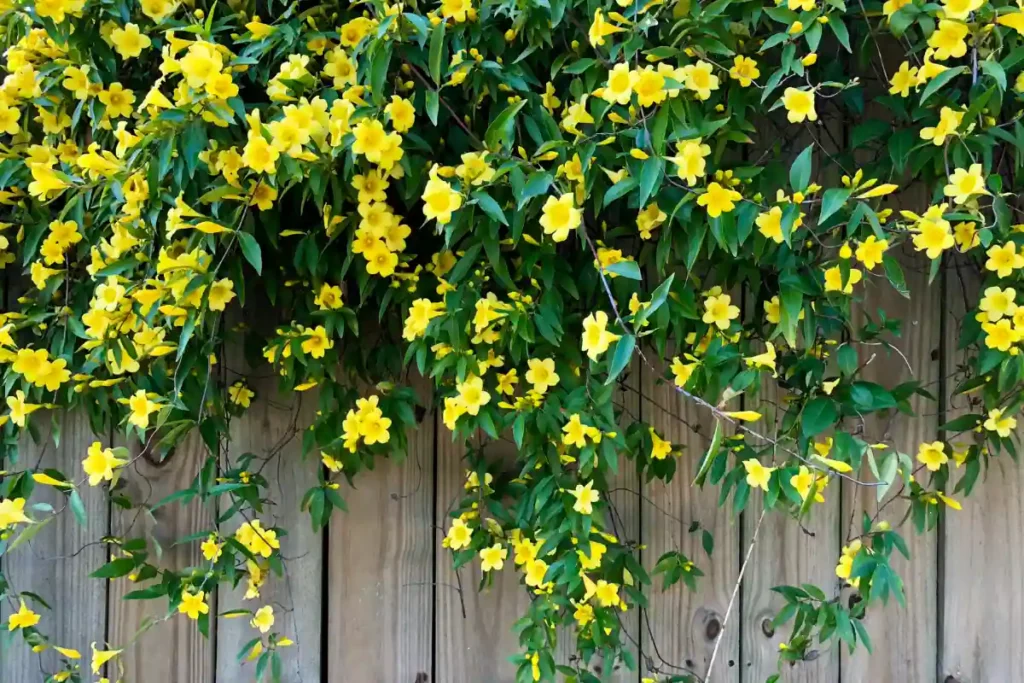
Carolina Jessamine shares water needs with the bird of paradise, making it an ideal companion plant.
Carolina Jessamine is a US-native plant. It is an evergreen, yellow-flowering climber you’re likely to find on a garden trellis and draped over rocks as a cover plant. It thrives in sunny areas around USDA zones 7 to 9 in the south.
However, it is highly toxic to humans and pets.
Society Garlic (Tulbaghia violacea)
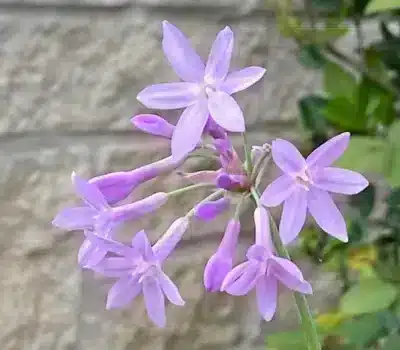
- Growing conditions: Full sun, moderate water, and sandy soil.
- Size: 1 to 3 feet
- USDA Zones: 7–9
- Flower Color: Lilac, lavender, pink
Like bird of paradise, society garlic thrives in full sunlight but can tolerate mild shade.
Society Garlic is a great ornamental plant and edible herb as an alternative to white garlic.
A South American native, Society Garlic is an excellent groundcover plant with an alluring scent and purple flowering.
It is a drought and cold-tolerant, clump-forming herbaceous perennial with narrow grass-like green leaves that look like chives.
This plant can grow up to 12 inches. They open on tall stems from early summer till late fall. Also, varieties such as Silver Lace and Variegata have more dramatic flowering.
Buy Society Garlic from Fast-Growing-Trees
Bougainvillaea vine
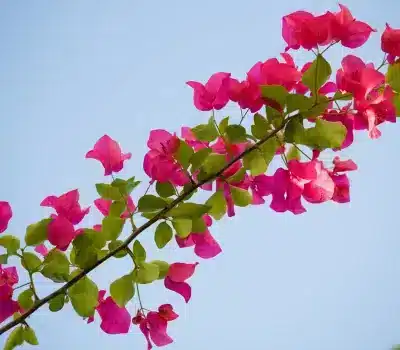
- Growing conditions: Full sun, gritty, fast-draining soil, and moderate watering.
- Size: 40 feet tall and 10 feet wide.
- USDA Zones: 9-11
- Flower Color: pink, magenta, purple, red, orange, yellow, and white.
Bougainvillea enhances the bird of paradise plants, displayed in USDA zone 10 with its heavy masses of bronze-tinged, orange blooms.
The Bougainvillea vine grows about 12 meters tall.
It is evergreen where there is rainfall but deciduous where it is dry.
The actual color of the flowers is white, but three or six bracts surround each cluster with bright colors associated with the plant, including pink, purple, red, orange, yellow, or white.
Sweet olive (Osmanthus fragrant)
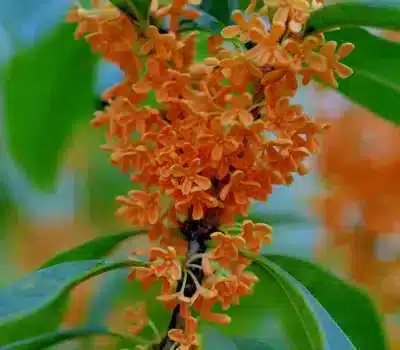
- Growing conditions: full sun or partial shade, weekly watering, and well-drained soil.
- Size: Up to 20-25ft tall and wide.
- USDA Zones: 7b – 9b
- Flower Color: creamy white, pure white, deep yellow, or orange
- Check Price of Sweet Olive here
The sweet olive plant will add an appealing apricot-scented blossom to your bird of paradise bed.
This evergreen shrub can grow up to 20 to 25 feet high but will usually reach 10 to 12 feet high and 8 feet wide in controlled environments.
As the plant matures, most of the foliage is held at the outermost end of the stem. However, the plant retains its beauty despite its legginess.
Although the most common color is white, it can vary from pale to deep yellow or orange, depending on the cultivar.
Dwarf sea holly (Blue hobbit)
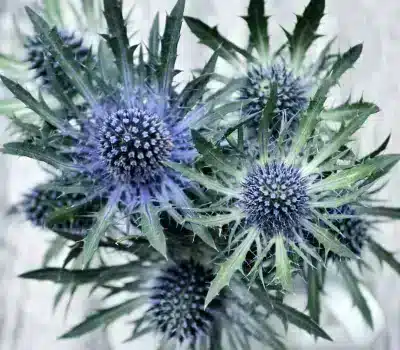
- Growing conditions: well-drained soils, full sun, and little watering.
- Size: 8-12″ tall
- USDA Zones: 5-9
- Flower Color: Blue, Purple, White
Foreground planting of the Dwarf sea holly emphasizes its flowers’ papery texture.
At just a foot high, this perennial’s silver-blue stems bear blue, conical flowers that will enclose in stiff, lance-like blue bracts.
Blue hobbit is drought tolerant and can thrive well in coastal and hot conditions. It is hardy in USDA zones 4 through 11.
Peruvian lily (Anouska princess lily)
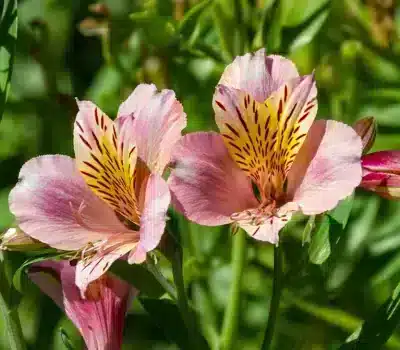
- Growing conditions: well-drained soil, full sun, and weekly watering.
- Size: 1–3 ft. tall, 1–2 ft. wide
- USDA Zones: 7-11
- Flower Colors: White, yellow, red, light pink, hot pink, purple, and orange.
Parrot lily adds floral brilliance to your bird of paradise plant garden. This plant is also attractive to butterflies, bees, and birds.
Peruvian lily is an easy-to-grow perennial flower that can be grown from spring to fall. They are 12 to 15 inches tall and grow in USDA zones 7 through 11. They do best in moist, sunny locations with full sun.
Red hot poker (knifophia)
Knifophia grows in USDA zones 5 through 9. It flowers from the bottom upwards and has flowering spikes of ivory, pale yellow, apricot, orange, and red that bloom in summer.
This plant is slightly salt-tolerant and is resistant to damage by deer.
Asiatic jasmine (Trachelospermum asiaticum)
- Growing conditions: Full sun, partial sun, or full shade; various soils; weekly watering.
- Size: 6 to 18 inches tall
- USDA Zones: 7a-11b
- Flower Color: White flowers
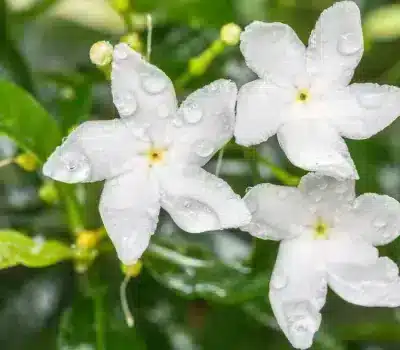
Asiatic jasmine is a popular, fast-growing plant that produces white to yellow, fragrant, star-shaped flowers.
The plant grows at least 3 feet wide and 6 to 18 inches tall.
It is native to Japan and Korea and is commonly used in Florida landscapes because of its hardy nature.
Asiatic jasmine is a low-maintenance ground cover excellent for mass planting and places where turfgrass won’t grow. It will tolerate many growing conditions with occasional edge trimmings.
Sago palm
- Growing conditions: Full sun, partial sun, sandy soil with organic matter, and little water.
- Size: 3 to 8 feet
- USDA Zones: 9-11
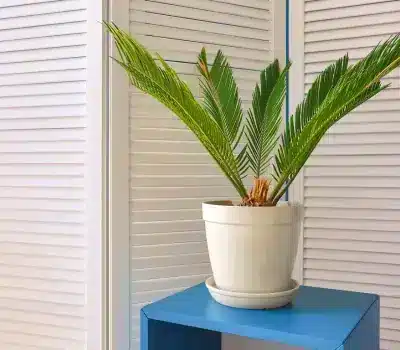
You can complete the tropical look by planting a showy sago palm next to your bird of paradise plant. Also, it does well as a houseplant or a centerpiece for your outdoor garden.
This evergreen plant is native to the tropical islands of Southern Japan but grows well in the subtropics of the United States. Slow-growing Sago palms can reach 4 to 5 feet long and 9 inches wide.
Bromeliads
- Growing conditions: Partial sun, little water, fast-draining soil
- Size: 6 inches to several feet tall
- USDA Zones: 10
- Flower Colors: pink, red, orange, and yellow
Bromeliads are low-maintenance plants that stand out for their bold, often colorful leaves and exotic flower spikes.
They thrive well in tropical and subtropical climates and can be used as a bedding plant for your outdoor bird of paradise plant.
They are slow growers that take up to 3 years to mature. Bromeliad flowers have three petals and three sepals, surrounding six stamens and one stigma.
Since bromeliads cannot survive freezing conditions, you can only enjoy them indoors in more temperate climates. Still, bromeliads can be planted both indoors and outdoors.
What should not be planted with bird of paradise?
Bird of paradise plants needs companion plants that enhance their color and form and share similar growing conditions.
Plants that do not tolerate drought cannot be planted with bird of paradise plants. Avoid planting the following plants with birds of paradise.
Lily of the valley
The conditions for growing the lily of the valley plants include partial to full shade, moist and organically rich loose soil. The plant cannot be planted with birds of paradise because of the difference in growing conditions.
Toad lily
Toad lily plant requires partial to full shade, moist, rich soil, and frequent watering. A bird of paradise cannot be planted with a toad lily because, unlike it, a bird of paradise does not require frequent watering. Also, a bird of paradise plant needs full sun to bloom.
Hydrangeas
Hydrangea plants do not like hot, dry, and exposed sites. They require a lot of water once per week. A bird of paradise plant requires full sun to thrive.
Astilbe
While birds of paradise plants are sun-lovers, astilbe plants thrive when grown in shades. Moist, fertile, humus-rich soil is a must-have condition for the astilbe plants to grow and bloom.
Do strelitzia need companion plants?
Strelitzia needs companion plants to improve the garden’s health. Plant plants compatible with birds of paradise plants near them to reap the following benefits.
Saving space
Companion plants make the best out of remnant spaces left by Strelitzia. You can either plant a slow-growing or quick-growing plant for more efficient gardening. You’re utilizing maximum space while growing more plants in your yard.
Keeping the soil moist and preventing erosion
Empty patches covered by companion plants would be prime ground for soil erosion. Planting companion plants keeps the soil moist and prevents soil erosion. Some companion plants will also improve the quality of soil for your bird of paradise plant.
Improving the garden’s visual appeal
Companion plants can be purely for aesthetic appeal. Bird of Paradise plants don’t bloom until they are mature. Planting annual blooming plants next to them will make your garden beautiful before Bird of Paradise peaks.
Attracting favorable insects
Insects such as bees are beneficial to your garden as pollinators and bug eaters. Planting companion plants with varying blooming periods will keep beneficial insects visiting your garden throughout the year.
Weed control
Ground coverage keeps the soil moist and controls organic weed growth. By planting creepers between the bird of paradise plants, you prevent weeds from growing.
Reducing the spread of disease
You can use nasturtium plants as a sacrifice to host diseases and pests to help protect your bird of paradise plant.
Helping with pollination
Many flowers often improve the growth of plants. Companion plants are good around your bird of paradise plant and deter a host of pests. Beneficial insects will spend more time in your garden if food and shelter are available. It is advisable to choose plants with extended bloom periods.
FAQ
What can I plant with orange bird of paradise?
The ideal companions for the brightly colored orange bird of paradise flower should be low-growing landscaping plants that match its water needs. Some great recommendations include Asiatic Jasmine, bromeliads, carissa, juniper, and peperomia.
Why is companion planting bird of paradise important?
Companion planting with Bird of Paradise (Strelitzia reginae) is important for enhancing garden aesthetics, promoting biodiversity, managing sunlight and shade, controlling pests, and conserving water.


